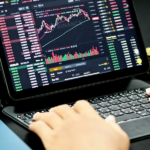Algorithmic trading refers to the use of computer algorithms to automate and execute trading strategies in financial markets. It has become an increasingly popular approach to trading over the past couple of decades.
The basic idea behind algorithmic trading is to use technology and quantitative analysis to develop rule-based trading strategies. These strategies can then be backtested on historical data to validate their profitability before being deployed live in markets.
Algorithmic trading first emerged in the 1970s when futures exchanges began offering computer-assisted trading systems. But it wasn’t until the 90s and 2000s that algorithmic trading took off, driven by advancements in trading software, market digitization, and low-latency infrastructure.
Major investment banks, hedge funds, and proprietary trading firms now rely extensively on algorithmic trading to execute orders and implement strategies, which has led to a surge in demand for sophisticated trading software development. It provides several advantages over manual trading, including speed, efficiency, reduced emotion, and the ability to back-test strategies. Retail traders have also increasingly adopted algorithmic trading software in recent years as platforms have become more accessible.
Overall, algorithmic trading now accounts for the majority of trading volume across most liquid financial markets. Some estimates suggest it makes up over 70% of trading in US equities and even higher percentages in other markets like futures and foreign exchange. As technology continues to advance, algorithmic trading will likely become only more pervasive going forward.
Understanding Algorithmic Trading
Algorithmic trading refers to the use of computer algorithms to automate and execute trading strategies in financial markets. It allows traders to systematize and automate their trading processes to increase efficiency, reduce emotion, and scale up strategies.
At a high level, algorithmic trading works by connecting to market data feeds, analyzing the data, generating trading signals, calculating optimal trade sizes/prices, and executing orders automatically. The key components and techniques involved include:
- Trading Strategies
- Indicators and Data
- Execution & Optimization
- Automation
Benefits of Algorithmic Trading
Algorithmic trading provides several key advantages over manual trading:
Speed
Algorithmic trading systems can analyze markets and place orders much faster than human traders. Orders are executed within milliseconds, providing the ability to capitalize on opportunities that may last only fractions of a second. High-frequency trading strategies in particular aim to profit from tiny market movements and momentary pricing anomalies. The speed of algorithmic trading allows taking advantage of fleeting micro-trends and price differentials across markets.
Consistency
Algorithmic trading applies rules and patterns consistently, without fear or hesitation. Human traders may experience emotions like greed, fear, impatience, fatigue, and regret, which can affect trading judgment. Algorithms stick to programmed logic and trading rules without deviation. This enforces consistent analysis, decision-making, trade entry, and exit across all market conditions.
Scalability
Trading strategies based on algorithms can be easily scaled up or down once implemented. Adding larger capital or trade frequency requires minimal additional effort. For human traders, increasing trading volume presents greater demands on their time and attention. Algorithmic trading systems allow setting parameters like trade size and entries/exits to scale as needed.
Cost Efficiency
After initial development costs, algorithmic trading systems can be less expensive to operate than relying on human traders. There are no salaries, benefits, bonuses, or overhead expenses involved. Algorithms can be run on cost-effective computing infrastructure. This scalability and low marginal cost of added capacity benefits algorithmic trading operations.
Getting Started with Python
Python has become one of the most popular programming languages for algorithmic trading due to its versatility, ease of use, and vibrant ecosystem of trading libraries. There are several key reasons why Python is well-suited for algorithmic trading:
- Simple and Readable Syntax: Python has a clear, readable syntax that is easy for beginners to learn but also powerful enough for advanced applications like quantitative trading. The emphasis on code readability makes Python programs easy to understand and maintain.
- Extensive Libraries and Tools: The Python ecosystem includes numerous open-source libraries specifically designed for trading, such as NumPy, Pandas, Matplotlib, TA-Lib, and more. These libraries provide pre-built functionality for data analysis, visualization, backtesting, broker integration, and other tasks required for systematic trading.
- Rapid Prototyping and Development: The interpreted nature of Python and its dynamic typing allow traders to quickly iterate on trading ideas and strategies. New strategies can be tested without the compile/build steps required by lower-level languages. Python is extremely productive for quickly building and evaluating trading models.
- Multi-paradigm Language: Python supports various programming styles including procedural, object-oriented, and functional programming. This flexibility allows traders to use the approach best suited for the problem at hand. Python can scale from simple trading scripts to large, complex algorithmic trading systems.
- Broad Compatibility: Python runs on various operating systems like Windows, Linux, and macOS. There are mature Python interfaces for connecting to data sources, brokerages, exchanges, and trading platforms. This makes Python a portable language for deploying algorithmic trading systems.
To start using Python for trading, you need to set up the Python interpreter and install key libraries like NumPy, Pandas, Matplotlib, TA-Lib, etc. The easiest way is to install a Python distribution like Anaconda that comes prepackaged with many of these libraries. You can use a Jupyter Notebook for an interactive development environment to build and test your trading strategies. With the right tools and libraries, Python provides an excellent platform for building robust algorithmic trading systems.
Data Acquisition and Preparation
Data is the lifeblood of algorithmic trading strategies. Before you can design and implement any quantitative trading strategy, you first need to acquire and prepare the data. This involves identifying appropriate data sources, cleaning and wrangling the raw data, and feature engineering to create the specific inputs your strategy will use.
There are several potential sources for acquiring historical financial market data. Professional vendors like Bloomberg, Thomson Reuters, and Pinnacle provide reliable, high-quality data sets covering equities, futures, forex, and more. However, their data feeds can be expensive. Free options include Yahoo Finance, Alpha Vantage, and Quandl which offer API access to download historical OHLCV data for stocks and other instruments. Alternative data sources beyond standard bars, Kaggle datasets, or scraping sites like FRED, COT reports, or Edgar filings could provide additional alphas.
Once data is acquired, it must be cleaned and wrangled into a usable format. This can involve handling missing values, filtering outliers, fixing data errors, normalizing features, and more. Python’s Pandas library provides many useful data preparation functions like fillna(), dropna(), replace(), etc. Proper data hygiene is crucial to avoid curve fits and bias. Always visualize and summarize the data at this stage to detect anomalies.
An essential part of data preparation is feature engineering. This means transforming and combining raw data into new inputs that better capture patterns your strategy intends to exploit. For algo trading, common engineered features include technical indicators like moving averages, volatility measures like Bollinger Bands, or economic indicators based on fundamental data. Creativity counts here. The more informative signals you can craft, the better chance your strategy has of capturing alpha.
With clean, featured training data in hand, you’re ready to design a profitable algorithmic trading strategy. Just don’t underestimate this critical upfront step. Garbage in, garbage out certainly applies to quant trading. Invest time in acquiring and preparing quality data, and it will pay dividends when it comes to strategy performance.
Designing Algorithmic Trading Strategies
Once you have acquired and prepared your data, the next step is to design the trading strategies that will be automated and executed. There are several common algorithmic trading strategy approaches:
Trend Following
Trend-following strategies aim to capture sustained moves in a particular direction. These strategies use indicators like moving averages and channel breakouts to identify the emergence of a trend, and trade with the trend until indications appear that the trend may be ending. Trend following models can be applied to any time frame or market.
Mean Reversion
Mean reversion strategies aim to profit from short-term reversals to the mean or average price. These models assume prices periodically fluctuate away from their value, then eventually revert towards the mean. Mean reversion strategies identify overbought and oversold conditions, then trade against the price extremes expecting price normalization.
Machine Learning Models
Machine learning techniques like neural networks can also be used to design algorithmic trading systems. The models are trained on historical data to uncover complex patterns and relationships. These models can continuously learn and adapt to new market conditions. The output is a model that can make probabilistic predictions on future price movements.
The choice of strategy depends on factors like the market being traded, investment style, risk tolerance, and computational resources. Often a combination of strategies is used to diversify and improve robustness. The key is finding an edge that gives you an advantage over random chance.
Backtesting and Validation
Backtesting trading strategies on historical data is crucial for evaluating their viability and expected performance. By testing strategies on past data, you can get an objective measure of how they might perform in live trading.
Some key aspects of backtesting include:
- Using historical price data that matches the assets and timeframes you plan to trade live. The data should cover different market conditions.
- Clearly define your strategy rules and metrics for evaluating performance. Common metrics include return, volatility, drawdown, Sharpe ratio, and alpha.
- Optimizing strategy parameters by iteratively testing different combinations to find the optimal values. This process is known as optimization.
- Analyzing the backtest results to understand wins, losses, and performance across different periods and market regimes. Look for consistent behavior.
- Evaluating performance in different market conditions – trending, range-bound, high/low volatility, etc. Strategies can perform very differently across changing markets.
- Using out-of-sample data for testing. Validate on recent data that wasn’t used for initial strategy development and optimization.
- Comparing strategy performance to relevant benchmarks to gauge excess returns.
- Checking for biases like curve-fitting that could affect live performance. Strategies can be over-optimized to historical data.
- Assessing how the strategy adheres to risk and portfolio constraints that would exist in live trading.
In summary, rigorous backtesting provides confidence in a strategy’s edge and an objective view of expected performance. It’s an essential part of developing and validating automated algorithmic trading systems.
Conclusion
In this guide, we covered the key concepts and steps for implementing algorithmic trading strategies in Python. By now, you should have a solid understanding of what algorithmic trading is, the benefits it provides, and how to get started with Python.
We walked through the process of acquiring and preparing financial data, designing rule-based trading strategies, backtesting them, and ultimately implementing automated trading based on those strategies in Python. Proper risk management techniques are critical for evaluating strategy performance and managing losses.
While algorithmic trading offers many advantages like rapid trade execution, emotionless decisions, and the ability to backtest, it also has risks like overoptimization and model risk. There is still further research needed into how to design robust strategies that can maintain profitability over time. This is an exciting and rapidly evolving field with many opportunities for innovation.
Some future directions for algorithmic trading include using more advanced machine learning algorithms, exploring alternative data sources, and adapting strategies across different asset classes and market conditions. As computing power continues improving, we may see even more sophisticated algorithms emerge. But the core foundations covered here will enable you to start developing your algorithmic trading strategies in Python today.





 Tags:
Tags:










